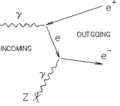Pair production facts for kids
In physics, pair production is what happens when a photon interacts with the nucleus of an atom, instead of the electron like in lower level x-ray interactions. The photon gives its energy to the nucleus and then creates a pair of positively and negatively charged electrons. The positive electron (positron) ionizes until it combines with a free electron. The two particles scatter in opposite directions.
The probability of pair production is proportional to the energy of the incoming photons and is affected by the material's atomic number. Pair production usually happens with energy levels over 25 MeV. Pair production happens sometimes in radiation therapy treatments with high-energy photon beams. It is somewhat related to photoelectric effect.
Images for kids
-
Diagram showing the process of electron–positron pair production. In reality the produced pair are nearly collinear. The black dot labelled 'Z' represents an adjacent atom, with atomic number Z.
-
Feynman diagram of electron–positron pair production. One must calculate multiple diagrams to get the net cross section
See also
 In Spanish: Creación de pares para niños
In Spanish: Creación de pares para niños


